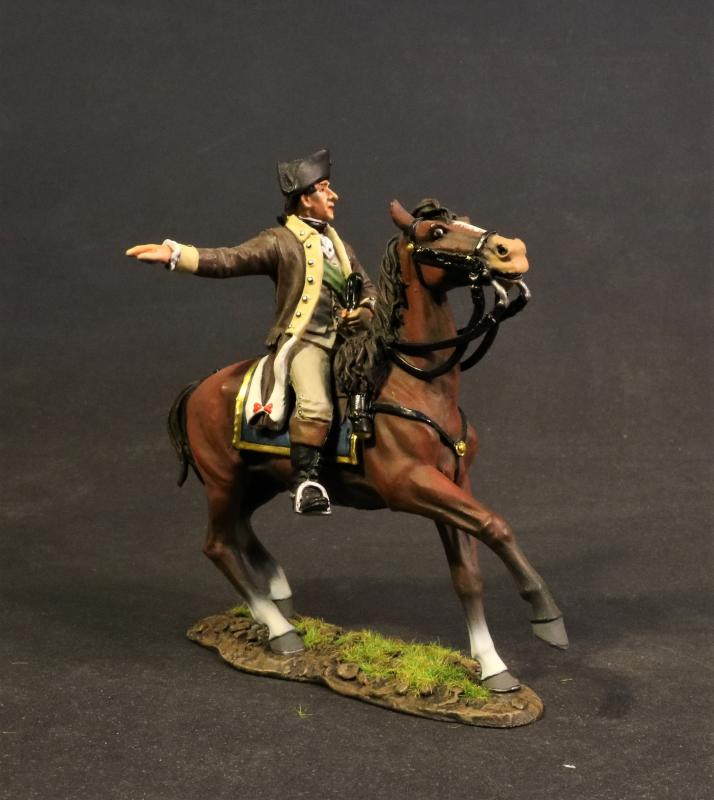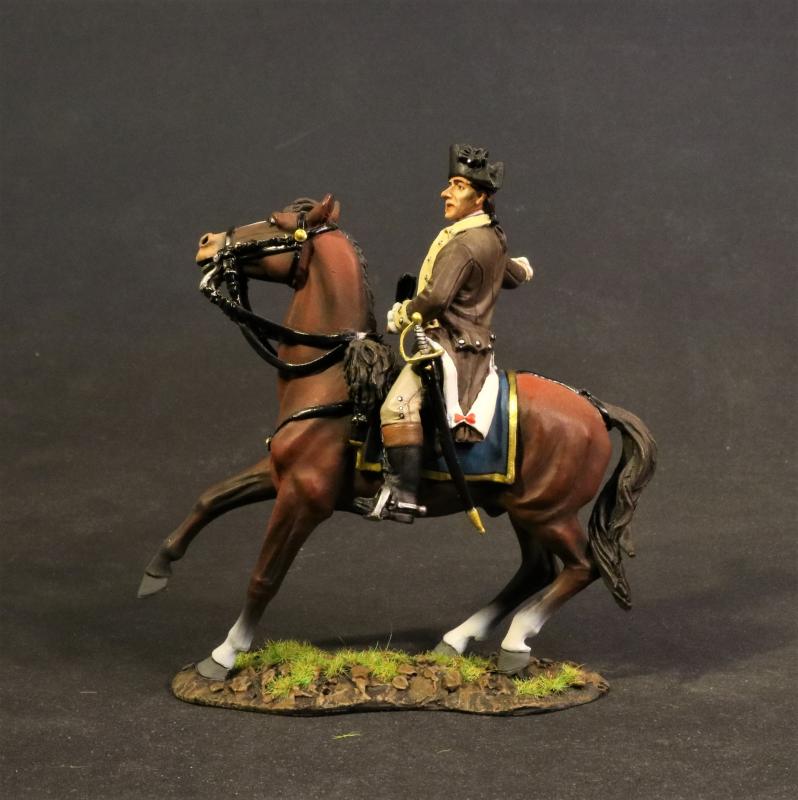Aide de Camp, Continental Army, The Battle of Saratoga, 1777, Drums Along the Mohawk--single mounted figure
$98.00
Item Number: SGEN-05
Aide de Camp, Continental Army, The Battle of Saratoga, 1777, Drums Along the Mohawk
Assault on the Breymann Redoubt, 7th October 1777
“The surrender that changed the world”.
In October 1777, a 6,000 strong British army surrendered in defeat after the American victory at the Battles of Saratoga.
For the first time in history a British General surrendered his sword
The German mercenaries were firing steadily from their redoubt.
From the rear came the crack of rifles. A general mounted and, his sword flashing, led the riflemen into the redoubt. German resistance collapsed. The Battle of Saratoga was over.
The day was Oct. 7th, 1777. Twelve days later, “Gentleman Johnny” Burgoyne, the gifted, courageous British commander, surrendered to the American general, Horatio Gates. Thus ended the most ambitious and dangerous offensive launched by Britain in the Revolution. The attack on the redoubt was the last of a series of actions that constituted the Battle of Saratoga, considered the turning point of the Revolution.
The rifle fire that decimated the Germans awoke echoes around the World. The French court, friendly to any who fought their ancient British enemy, finally was convinced that France’s interest lay in entering the war on the side of the Americans.
Following intense fighting with the Continental Army in September, the British Army fortified themselves behind two defensive redoubts--the larger, better defended Balcarres Redoubt, and the weaker Breymann Redoubt.
American forces, led by General Benedict Arnold, managed to take the Breymann Redoubt, which gave them a strong position behind the British lines. The loss of the Redoubt rendered the British position untenable. The British Army was forced to pull back to the river, from which position they would attempt to retreat north the next morning.
THE CONTINENTAL ARMY
The Continental Army was formed by the Second Continental Congress after the outbreak of the American Revolutionary War by the colonies that became the United States of America. Established by a resolution of the Congress on June 14, 1775, it was created to coordinate the military efforts of the Thirteen Colonies in their revolt against the rule of Great Britain. The Continental Army was supplemented by local militias and troops that remained under control of the individual states or were otherwise independent. General George Washington was the commander-in-chief of the army throughout the war.
The Continental Army consisted of soldiers from all 13 colonies and, after 1776, from all 13 states. When the American Revolutionary War began at the Battles of Lexington and Concord on April 19, 1775, the colonial revolutionaries did not have an army. Previously, each colony had relied upon the militia, made up of part-time citizen-soldiers, for local defense, or the raising of temporary "provincial regiments" during specific crises such as the French and Indian War of 1754–63. As tensions with Great Britain increased in the years leading to the war, colonists began to reform their militias in preparation for the perceived potential conflict. Training of militiamen increased after the passage of the Intolerable Acts in 1774. Colonists such as Richard Henry Lee proposed forming a national militia force, but the First Continental Congress rejected the idea.
The Continental Army of 1777–80 evolved out of several critical reforms and political decisions that came about when it became apparent that the British were sending massive forces to put an end to the American Revolution. The Continental Congress passed the "Eighty-eight Battalion Resolve", ordering each state to contribute one-battalion regiments in proportion to their population, and Washington subsequently received authority to raise an additional 16 battalions. Enlistment terms extended to three years or to "the length of the war" to avoid the year-end crises that depleted forces (including the notable near-collapse of the army at the end of 1776, which could have ended the war in a Continental, or American, loss by forfeit).
Three of the Continental Army units which took part in the assault on the Breymann Redoubt, were the 2nd Massachussetts, the 2nd New York, and the 1st Canadian Regiment.
AIDES-DE-CAMP during the American Revolutionary War were officers of the Continental army appointed to serve a senior commanding officer. They would serve with the rank of Lieutenant Colonel.
On the battlefield, the Aides-de-Camp were basically couriers, delivering their commanders orders on horseback and gathering or relaying intelligence on enemy troop movement.
George Washington, as commander in chief, was officially assigned one military secretary, and three Aides-de-camp, (although he petitioned for two more), and also supplemented his command with volunteers. Casualties were common, and, throughout the war, Washington used thirty-two different Aides-de-Camp.
Samuel Blachley Webb was wounded on October 28th 1776 at the Battle of White Plains, and on December 26th 1776 at the Battle of Trenton.
Tench Tilghman served longer than any other Aide-de-camp, more than seven years, although about half was served as a volunteer.
Released in JANUARY 2020.

